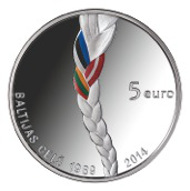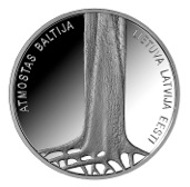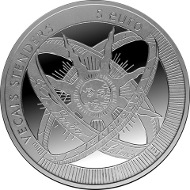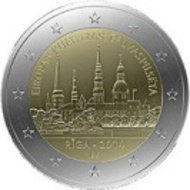December 4, 2014 – Latvia brings three new commemorative coins, celebrating unity among the Baltic states, the 300th anniversary of the Latvian writer, linguist and thinker Gotthard Friedrich Stender and Riga’s distinction as European Capital of Culture 2014.
Latvia/ 5 EUR/ Silver .925/ 22 g/ 35 mm/ Designer: Visvaldis Asaris and Ligita Franckevica.
Collector Coin “Baltic Way”
The obverse is crossed by a braid with ribbons in the colours of national flags of the three Baltic Republics woven in it. The inscription “5 euro” is on the right. The lower left part of the obverse bears the semi-circled inscription BALTIJAS CELS 1989, with the year 2014 on the right.
The reverse displays a vertical image of a tree trunk with exposed roots. There are two semi-circled inscriptions – ATMOSTAS BALTIJA (Awakening Baltics) on the left and LIETUVA LATVIJA EESTI (Lithuania Latvia Estonia) on the right.
The edge features two inscriptions LATVIJAS BANKA and LATVIJAS REPUBLIKA, separated by rhombic dots.
The idea of freedom is one for which people have always been willing to pay the highest price. In Estonia, Latvia and Lithuania the yearning for freedom found a powerful expression at the end of the 1980s. The Baltic peoples were united by a common goal: to shake off the shackles of the Soviet totalitarian empire, which had meant subjugation of half a century and which had originated in the Molotov–Ribbentrop Pact. This mutual non-aggression pact signed on 23 August 1939 by the USSR and Germany was supplemented by a secret protocol, which in fact meant the division of six independent European states into spheres of influence and occupation.
The Molotov–Ribbentrop Pact prepared and initiated World War II. The USSR, an active ally of Nazi Germany, occupied the Baltic States in the summer of 1940 in direct consequence of the pact. The social and economic orders were forcibly changed in accordance with the interests of the USSR and subject to the dictatorship of communist ideology and regime. The Baltic States were incorporated into this superpower, experiencing deportations and killing of their citizens, nationalisation and collectivisation, political terror and life behind the “iron curtain” in isolation from the world.
Fifty years after the criminal Molotov–Ribbentrop Pact was signed, on 23 August 1989 at 7 p.m., about two million residents of the Baltic countries joined hands forming a 600-kilometre-long human chain that joined Tallinn, Riga and Vilnius for 15 minutes. This unique action drew the attention of the entire world, highlighting the historical injustice and asserting that the idea of freedom and independence is very much alive in the minds and hearts of the three Baltic nations. In the lexicon of non-violent struggle, the message of Awakening, Popular Front and Singing Revolution was supplemented by another striking entry – the Baltic Way. It was like an informal referendum that demonstrated to the occupation power how united the Baltic nations were in their desire to regain their freedom and renew their independence. The Baltic Way demonstrated the effectiveness of non-violent struggle and the power of unity.
In 1991, the Baltic nations regained their statehood and political independence. The withdrawal of occupation troops, admittance of the Baltic countries to the United Nations and later to the European Union, NATO and many international organisations were natural milestones in their subsequent journey. On 30 July 2009, UNESCO included the documentary testimonies of the Baltic Way in the international register “Memory of the World”. This Latvian euro coin is dedicated to the 25th anniversary of the striking event demonstrating unity among the three Baltic nations.
Latvia/ 5 EUR/ Silver .925/ 22 g/ 35 mm/ Designer: Aigars OzolinS and Janis Strupulis/ Mintage: 10,000.
Collector Coin “Old Stenders”
A theme from the title page of the first edition of the “Book of High Wisdom on the World and Nature” (1774) by Gotthard Friedrich Stender (1714–1796) is a central motif: a pastor is showing a boy how full of wonders this world is. At the top on the left, there are semi-circled inscriptions 2014 and LATVIJA.
The reverse of the coin features the progressive idea of the world, the heliocentric concept of the universe. The image comprises the inscriptions “G. F. Stender” and “Latwis”. Above it, there are semi-circled inscriptions VECAIS STENDERS on the left and “5 euro” slightly on the right.
The inscriptions LATVIJAS REPUBLIKA and LATVIJAS BANKA, separated by rhombic dots.
The UNESCO events calendar for 2014 includes, among others, the 300th anniversary of the Latvian writer, linguist and thinker Gotthard Friedrich Stender (1714–1796), thus celebrating his fundamental contribution in the area of culture, education and science, including inter-cultural dialogue.
G. F. Stender (nicknamed Vecais Stenders, Old Stenders) is an outstanding representative of the 18th century Enlightenment. He was a German born in the pastoral estate of LaSi (now Eglaine), Duchy of Courland and Semigallia. He studied philosophy and theology at Universities of Jena and Halle and served both as a pastor and as an inventor (he made globes for the royal court of Denmark; provided a method for determining the geographical longitude at sea, and even constructed a primitive washing machine). In 1765, he returned to his native land and spent the last thirty years of his life to enlighten and educate the Latvian serfs.
Old Stenders is considered the founder of Latvian secular literature: he wrote fairy-tales, fables, short stories and popular songs; he compiled ABCs in Latvian and performed tasks essential for the formation of a cultural nation: writing a grammar of the Latvian language and putting together a Latvian–German and German–Latvian dictionary.
Old Stenders’ most outstanding work is his “Book of High Wisdom on the World and Nature” (1774), in fact, the first peasant encyclopaedia in Europe. There, Old Stenders explains natural phenomena and the basic principles of physics and astronomy, including rotating of the Earth around its axis and around the Sun, and gives basic insights into issues related to meteorology, zoology, botany, chemistry and geography as well as tells his readers about mountains and deserts, earthquakes and volcanoes, seas and rivers.
Old Stenders may not have had the range of other figures of the Enlightenment like Jean-Jacques Rousseau, Voltaire, Denis Diderot, or Johann Gottfried Herder, yet his contribution to the evolution of Latvian nation is invaluable. He taught Latvians to think and was the first to offer praise to his native land in poetry. Confirming his unity with the emerging Latvian nation, he had his headstone in Sunakste (now Viesite region) supplemented with the word “Latwis” – Latvian.
The obverse of the coin dedicated to Old Stenders has borrowed the theme from the title page of the first edition of the “Book of High Wisdom on the World and Nature”: a pastor is showing a boy how full of wonders this world is. The reverse of the coin features the progressive idea of the world, the heliocentric concept of the universe.
Latvia/ 8.5 g/ 25.75 mm/ Designer: Henrihs Vorkals and Janis Strupulis/ Mintage: 1,000,000, plus 5,000 (BU).
2 euro Commemorative Coin “Riga – European Capital of Culture 2014”
The central image of the coin shows the skyline of Riga, with inscriptions “RIGA – 2014” and “LV” underneath. At the top of the image there is a semi-circled inscription “EIROPAS KULTURAS GALVASPILSETA” (European Capital of Culture). The coin’s outer ring depicts the 12 stars of the European flag.
The inscription “DIEVS SVETI LATVIJU” (God, Bless Latvia), with the words separated by stars.
Riga is the European Capital of Culture 2014. This designation and the activities related to the event present a new quality vision of the capital city and entire Latvia’s affinity with Europe and the common cultural values.
The Programme of the European Capital of Culture comprises several hundreds of specially-designed events. Over 12 thousand people from almost 100 cultural establishments and non-governmental organisations have been involved in the Programme.
Quite a lot of events have resulted from successful partnership of Latvian and foreign creative groups and will be presented in Riga and Latvia for the first time. The Programme includes cultural events of global and European significance, among them concerts, exhibitions, shows and performances staged by Riga residents in 58 environs of the city.
“Force Majeure” – this is the name given to the Programme of European Capital of Culture of Riga. Culture as force majeure: via events of various genres and the interplay among different spheres of life Riga aspires to enhance the conviction that culture can change people’s lives to the better. Riga is the city of inspiration!
Visit Latvijas Banka here.
Or see what’s happening culturally in Riga in this year.










